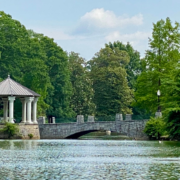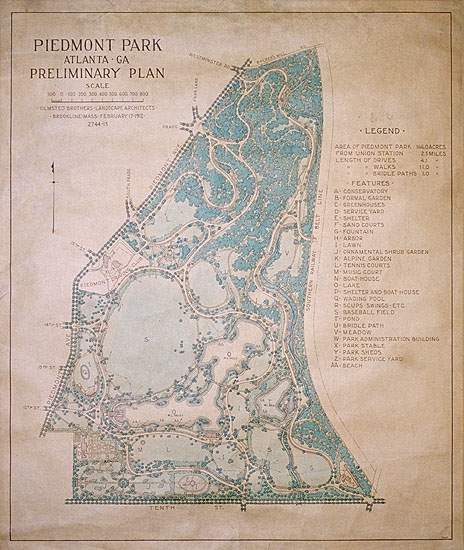Olmsted and Piedmont Park History
Here are five fun facts about the Olmsted family and its influence on Piedmont Park.
- Frederick Law Olmsted was the co-designer and builder of Central Park. He was the foremost Landscape Architect of the last half of the 1800’s and did many major commissions including the grounds of the US Capitol, the 1893 Columbian Expo in Chicago (setting of Devil in the White City) and the grounds of Biltmore House in Asheville. Other prominent projects include Brooklyn’s Prospect Park, Boston’s Emerald Necklace, and the campuses of Wellesley, Smith, and Stanford. He was an early voice for conservation and contributed to the plans for Niagara Falls and Yosemite.
- Olmsted designed the Druid Hills neighborhood in Atlanta and the Linear Parks along Ponce still maintain his plan. While in Atlanta in 1894, Olmsted consulted with the planners of the Cotton States Expo. (Landscape Architect Grant Wilkins is credited with the design as built.)
- The city of Atlanta purchased the derelict Expo grounds for a city park in 1904. In 1911, the city hired Olmsted’s sons to draw up a master plan for Piedmont Park. Their firm wasn’t hired to build the plan, but much of the Olmsted Brothers’ design was implemented through the years, including the Park Drive Bridge of 1916, and it heavily influenced the Master Plan approved in 1993.
Olmsted Brothers’ 1912 Piedmont Park Master Plan
- Olmsted principles of park design can be seen in Piedmont Park’s meandering roads and paths which curve and cross each other, making triangles. The winding walks and changes of elevation provide interest with ever-changing views. Wide open fields are interspersed with trees, lakes and natural plantings. Different areas of the park host varieties of activities. Olmsted’s ideas continue to be highly influential. He has been called the Father of Landscape Architecture.
- Olmsted’s scenic, relaxed pastoral style made the enjoyment of nature a benefit available to everyone and a respite from the stresses of city life. Olmsted believed in parks as a social good providing relaxation and improved health for people of all levels of education and income. (Compare to parks with straight paths and formal gardens, originally available only to the wealthy, showing dominance over nature.)
Parks are the only places where vast numbers of persons are brought closely together, poor and rich, young and old, each individual adding by his mere presence to the pleasure of others.
– Frederick Law Olmsted, 1870
This quote is engraved in one of the blocks in the horseshoe-shaped donor monument in front of Dockside (historically known as the Visitor Center, Ladies’ Comfort Station).
Author: Ginny Connelly, Piedmont Park Conservancy Docent
Want to learn more about Piedmont Park’s history? Join us for a tour which features Olmsted’s influence and many other stories along the years. Tour Webpage
In March and April of 2022, Piedmont Park Conservancy is a proud partner of the #Olmsted200 Celebration and will be offering guided history tours focused on Olmsted’s influence. Learn more at Olmsted200.org.


